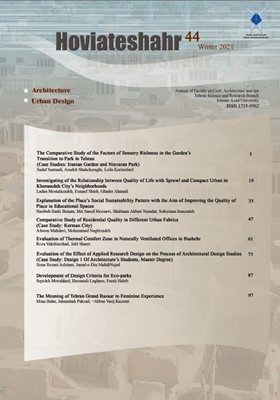-
-
List of Articles
-
Open Access Article
1 - The Comparative Study of the Factors of Sensory Richness in the garden’s transition to park in Tehran (Case Studies: Iranian Garden and Niavaran Park)
sadaf sarmadi Azadeh Shahcheraghi leila karimi fard -
Open Access Article
2 - Investigating of the relationship between quality of life with sprawl and compact urban in Khoramdeh city’s neighborhoods
Ladan Mostafazadeh Esmaeil Shieh Ghader Ahmadi -
Open Access Article
3 - Explanation of the Place’s Social Sustainability Pattern with the Aim of Improving the Quality of Place in Educational Spaces
Nasibeh Badri Benam Mir Saeed Moosavi Akbari Namdar Shabnam Soleyman Iranzadeh -
Open Access Article
4 - Comparative study of residential quality in different urban fabrics (Case study: Kerman)
Afsoon Mahdavi Mohammad Naghizadeh -
Open Access Article
5 - Evaluation of Thermal Comfort Zone in Naturally Ventilated Offices in Bushehr
Roza Vakilinezhad Jalil Shaeri -
Open Access Article
6 - Evaluation of the Effect of Applied Research Design on the Process of Architectural Design Studios(Case Study: Design 1 of Architecture’s Students, Master Degree)
Sima Rezaei Ashtiani Jamal-e-Din MahdiNejad -
Open Access Article
7 - The Meaning of Tehran Grand Bazaar in Feminine Experience
Mina Bidar Jahanshah Pakzad Abbas Varij Kazemi -
Open Access Article
8 - Development of Design Criteria for Eco-parks
Sepideh Movahhed Hasanali Leghai Farah Habib
-
The rights to this website are owned by the Raimag Press Management System.
Copyright © 2021-2025







